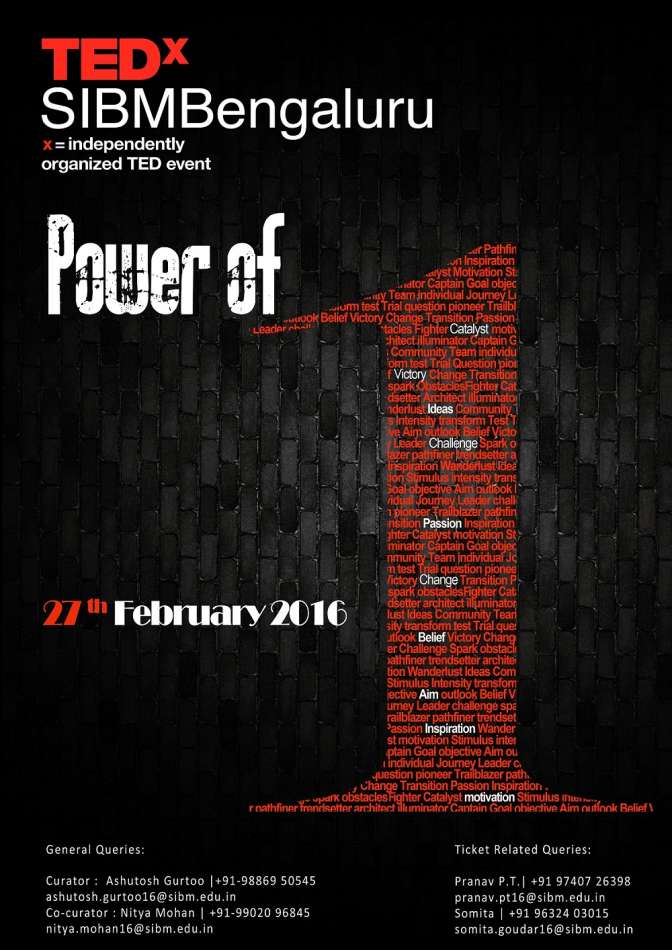“Everyone here has the sense that right is one of those moments when we’re influencing the future” – Steve Jobs
The stage was set and it was time to host the most sought after event of IIFT – The National IT Conclave 2014. Organized at the posh Swissôtel, Kolkata, The National IT Conclave 2014 was on the theme ‘The Next Big Thing in Indian IT’. The conclave aims at providing a platform to the business leaders to share their vision on emerging trends and propose ways to tackle challenges in the Indian IT Industry. It provides a golden opportunity for students to interact with the industry veterans in Indian IT and learn about the latest paradigm shift in IT Applications. Mr. C.S. Ghosh, Chairman and Managing Director, Bandhan Financial Services Ltd. was the distinguished Chief Guest of the event.
The opening speech of Ashish Dada clearly indicated that we are here to make it BIG and there are no half measures. The speech from the student representative had a distinctive flair, which clearly indicated that we are among the best of the best B-Schools in India
The conclave was divided into three sessions and an inaugural session which set the theme for the day. Dr. K. Rangarajan, Center Head at IIFT Kolkata welcomed the guests and stated that there was a pressing need to readdress existing imbalances in the IT Industry. He reiterated the rapid strides taken by the IT industry and the importance of support services to manufacturing sector. He said that, “Productivity enhancement in the sunrise sectors can achieve dramatic growth with the support of IT”.
Mr. C.S. Ghosh enlightened the audience on how Bandhan had used IT in creating value for customers. Although Bandhan started in 2001, the use of IT infrastructure started in only 2006. Throwing light on the limitations of IT, he said that “Without power and connectivity, IT cannot be used.” IT had helped to streamline the process of sending data from the field to the central server and therefore has brought about a radical overhaul in the functioning of the organization. He suggested that there were four broad strategies that can be used which include ,’Cost advantage’, ‘Using IT to empower people’, ’IT as a tool for future’ and ‘Improving the comfort level for the stakeholders.’ He concluded by saying that the most important contribution of technology has been “bringing hope for the poor”.
Mr. Sanjeev Nandwani (Development Commissioner, SEZs, Ministry of Commerce and Industry, Government of India), who has had a long-standing relationship with IIFT, focused on how the government can help optimize the use of IT for India’s development. From reducing the use of reams of paper in offices to allotting a single unique ID instead of the various numbers that are presently in use, IT can be harnessed for myriad applications. As Mr. Nandwani pointed out, India has gained expertise in maintenance and development in IT but what we lack is “the ability to think disruptive innovation”. He went ahead to congratulate the IT sector for having contributed significantly towards the development of India.
SESSION 1: Recharging E-Governance
The first session was related to e-governance and how it can transform the Indian landscape. Although the Indian IT Industry has brought about a radical overhaul in the economy of our country yet it has not had the desired effect in the domestic sector. This has been mainly due to the impediments for the IT Industry which needs to be removed for the successful implementation of the policies.
Sanjoy Gupta,Partner, Market Leader – Government Sector for Eastern Cluster, EY delivered a thought provoking speech on how “India needs a kranti in E-governance”. He emphasized on how the Government needs to be meaningful and transparent and fulfill the needs of the society by engaging the three stakeholders namely the Business Community, the Government and the people at large.
Pradip Bhowmick captured the imagination of the audience by sourcing real-life examples
Pradip Bhowmick, Executive Director and Partner, PriceWaterhouseCoopers, enlightened the audience about categorizing the IT services into three categories namely Open Data, Cloud and Mobile. Open Data refers to pushing the services for the public and running the analytics to better the policy making process. Meghraj was discussed as an example of Cloud services. He proposed that the programme of Digital India would enable the government to disburse public services efficiently and swiftly.
Priyankur Roy, Director & Head of Consulting CSI GSI, Ericsson articulated his thoughts about the current and desired state of e-Governance in the country. He stated that Mobile broadband, Cloud, Analytics and M2M services would be the drivers of e-Governance in the future. He remarked that, “M2M would facilitate connection of machines with other machines and this would result in a society in which anything that could be connected would be connected”. Cloud would provide scalability to this model. Big Data and analytics would finally complete the picture. He also emphasized automation of knowledge workers to bring in efficiency so that individuals with 35+ ages can undertake the task of being innovators and improve the delivery of IT services.
Session 2: SMAC in the Indian Context
The second session dealt with SMAC (Social Media, Analytics and Cloud) in the Indian Context. With Data being tipped as the new oil, IT Industry needs to tap the huge potential that SMAC offers. It also focused on the potential growth oriented areas like mobile technology, e-commerce and cloud computing.
Pritam Kanti Paul, CoFounder & Director – BRIDGEi2i Analytics Solutions commenced the session by illustrating how the volume of data is increasing and storage costs is decreasing. He stated that the world is changing and now analytics is the top priority of CIOs of the company. He stated that the need of analytics is changing and personalization is the top priority of companies. Simplification of processes and improving the operations are the other areas in which help of analytics is being sought.
Sudipto Ray, Managing Director, Application Services, Accenture charmed the audience by downloading a countdown app on his cellphone and illustrating how the services are now available at our fingertips according to our needs. He stated that social needs are driving the outcome of the services and disruption is the buzz word. He said,” New technology and innovation is shrinking the life cycle of the product”. He concluded by stating that Traditional Brick-n-mortar would continue to exist but the services would gravitate towards IT.
Snehamoy Mukherjee, Associate Principal and Analytics Leader (Retail), Axtria India started on a contrary note by stating that “Analytics is not the next Big Thing in Indian IT Industry”. He gave insightful examples on how “Data visualization is one big area of opportunity”. He also stated that companies have failed in using analytics effectively because they put it under the domain of Business Process Outsourcing. He also brought out new interpretations of words like PIG, Latin, Hadoop and Nearest neighbour and linking them to analytics.
Kaushik Dey, GM at Strategy and Analytics Practice, IBM started by stating that “Data is everywhere”. He also discussed about the various types of analytics like Predictive Analytics, Data Analytics, Real time Analytics and Streaming analytics. He also demonstrated the concept of how Analytics can aid in the process of marketing by sharing the customer journey of a hypothetical digital customer ‘Amrita’.
The event was also marked by excellent coordination and stellar performance of Nitika Gupta which left the audience spell-bound
Session 3: Saturation vs. Satisfaction
The final session was on ‘Saturation vs. Satisfaction’ focusing on the role of HR managers in creating a conducive environment for the IT workforce. Managing, retaining and training the relevant talent are the areas that need new ideas with reference to the next phase of Indian IT.
The last session of the day was compered by our very own Ravi Bhai from Delhi, who with his excellent combination of oratorical skills and event organization, left the speakers overwhelmed. Ms. Ishita Bardhan spoke on saturation in IT industry and factors that are causing this perception of saturation. She pointed out that the “multivendor culture in IT is here to stay” and focused on rising level of automation and standardization– from cost cutting, procurement, HR practices, legal norms to safety measures for employees at workplace. She shared valuable insight on how to enhance job satisfaction for IT employees and proposed a quick tool, “Fit for You” card to identify and explore the most important factors leading to employee satisfaction in any organization.
Ms. Atriya Bannerjee talked on the currently faced HR challenges. She added to the topic of employee satisfaction that a fun workplace and ample leadership opportunities combined with use of social media can lead to a more productive employee. Mr. Aloke Tagore, the Regional HR Head – East at Deloitte, discussed the motivation and hygiene factors that come into play in any workplace. He further elaborated upon saturation and the effect it has on the world of IT.Mr. Chirabrata Majumdar touched upon the importance of linking profession to rewards through interesting examples. He emphasized on the importance of talent measurement in IT and how the process should be transparent through the proposed solution dubbed “Pooh’s Panacea” wherein “definite drivers should be set with respect to which employees should benchmark themselves.”
Thanks to the students, The National IT Conclave was trending big time on Twitter and captured the imagination of the IT players across the world with real-time tweets of the happenings. The conclave also turned into an informal photo session ensuring that we keep the memories of the mega event preserved forever.
The soon-to-be-managers proved to be able listeners and had various questions ranging from the invasion of privacy in Analytics to the limitations of rural penetration for effective implementation of E-Governance. The presence of eminent personalities from the industry showcased the brand appeal enjoyed by IIFT in the corporate sector.
Finally the vote of thanks from Avinash Saproo clearly reflected the amount of hard work the core committee volunteers and the IMF has put in to make it a grand success. However, the event could never have been conducted with such brilliance without the herculean efforts of the coordinators of the Systemix Club – Swapnil Pandey and Shamir Alam, who gave it their all to make IIFT feel proud yet again. The event was a huge success with respect to both the amount of knowledge shared as well as participation of the dignitaries from the corporate sector.
As we draw curtain to the event and as we sit back to think about the sweet memories which we take home today from a day well spent with friends and of course the sumptuous lunch (truly worth the deal) and a sense of accomplishment, we wish in the years to come the legacy of the National IT Conclave goes on and continues to make us feel proud. Hail IIFT!
You might like reading:

TEDxSIBMBengaluru is back with the Power of One
Bengaluru: Symbiosis Institute of Business Management, Bengaluru hosted its fifth edition of TEDxSIBMBengaluru on Saturday, February 27th with noted speakers including amputee cyclist Aditya Mehta, mentalist Aathi, top cop turned educationalist Abhayanand, violin virtuoso Sangeetha Shankar. With the theme ‘Power of One’, TEDxSIBMBengaluru envisions that its live speakers, talks, videos and interactions shall combine to spark profound discussions and inspire […]

Minimum Alternate Tax (MAT) and its impact on FIIs
Minimum Alternate Tax (MAT) is not a novel concept. It has been in existence in India for at least for the last two decades. The reason for the imposition of MAT is pretty simple – Companies with significant incomes, which even go the extent of companies distributing dividends to shareholders, take advantage of incentives and deductions to show close to […]






























